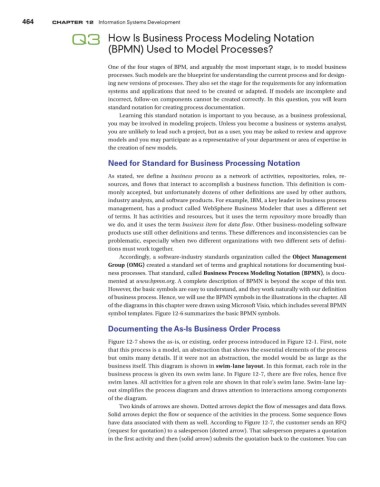Page 496 - Using MIS
P. 496
464 Chapter 12 Information Systems Development
Q3 How Is Business Process Modeling Notation
(BPMN) Used to Model Processes?
One of the four stages of BPM, and arguably the most important stage, is to model business
processes. Such models are the blueprint for understanding the current process and for design-
ing new versions of processes. They also set the stage for the requirements for any information
systems and applications that need to be created or adapted. If models are incomplete and
incorrect, follow-on components cannot be created correctly. In this question, you will learn
standard notation for creating process documentation.
Learning this standard notation is important to you because, as a business professional,
you may be involved in modeling projects. Unless you become a business or systems analyst,
you are unlikely to lead such a project, but as a user, you may be asked to review and approve
models and you may participate as a representative of your department or area of expertise in
the creation of new models.
Need for Standard for Business Processing Notation
As stated, we define a business process as a network of activities, repositories, roles, re-
sources, and flows that interact to accomplish a business function. This definition is com-
monly accepted, but unfortunately dozens of other definitions are used by other authors,
industry analysts, and software products. For example, IBM, a key leader in business process
management, has a product called WebSphere Business Modeler that uses a different set
of terms. It has activities and resources, but it uses the term repository more broadly than
we do, and it uses the term business item for data flow. Other business-modeling software
products use still other definitions and terms. These differences and inconsistencies can be
problematic, especially when two different organizations with two different sets of defini-
tions must work together.
Accordingly, a software-industry standards organization called the Object Management
Group (OMG) created a standard set of terms and graphical notations for documenting busi-
ness processes. That standard, called Business Process Modeling Notation (BPMN), is docu-
mented at www.bpmn.org. A complete description of BPMN is beyond the scope of this text.
However, the basic symbols are easy to understand, and they work naturally with our definition
of business process. Hence, we will use the BPMN symbols in the illustrations in the chapter. All
of the diagrams in this chapter were drawn using Microsoft Visio, which includes several BPMN
symbol templates. Figure 12-6 summarizes the basic BPMN symbols.
Documenting the As-Is Business Order Process
Figure 12-7 shows the as-is, or existing, order process introduced in Figure 12-1. First, note
that this process is a model, an abstraction that shows the essential elements of the process
but omits many details. If it were not an abstraction, the model would be as large as the
business itself. This diagram is shown in swim-lane layout. In this format, each role in the
business process is given its own swim lane. In Figure 12-7, there are five roles, hence five
swim lanes. All activities for a given role are shown in that role’s swim lane. Swim-lane lay-
out simplifies the process diagram and draws attention to interactions among components
of the diagram.
Two kinds of arrows are shown. Dotted arrows depict the flow of messages and data flows.
Solid arrows depict the flow or sequence of the activities in the process. Some sequence flows
have data associated with them as well. According to Figure 12-7, the customer sends an RFQ
(request for quotation) to a salesperson (dotted arrow). That salesperson prepares a quotation
in the first activity and then (solid arrow) submits the quotation back to the customer. You can

